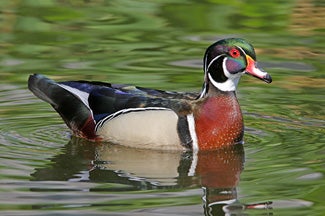SCIENTIFIC NAME:
Aix sponsa
OTHER NAMES:
Woodie, summer duck, acorn duck, swamp duck, squealer.
STATUS:
Breeder. Common in all seasons and regions. Low Conservation Concern.
DESCRIPTION:
The wood duck (Aix sponsa) is a small, multicolored duck from 15 inches to 18 inches in length that inhabits creeks, rivers, floodplains, lakes, swamps, and beaver ponds. Their crested heads, broad wings, and large rectangular tails create an appearance unlike any other duck. Although their flight is only moderately swift compared to other ducks, their somewhat broader wings enable them to thread their way through tree branches fairly easily. The male wood duck is brightly colored and patterned in iridescent greens, purples, and blues with a distinctive white chin patch and a long, red bill. In flight, the white belly contrasts neatly with the dark breast and wing feathers. Females are a mottled brown color with a white, eye patch. Wood ducks make a loud wooo-eek during flight and when under distress. During feeding and resting they make softer peet and cheep notes. On the water, wood ducks sit higher and are more buoyant than other ducks. Due to their buoyancy, their tails are usually visible an inch or more above the water.
DISTRIBUTION:
The wood duck is widely distributed in North America. It can be found throughout the East Coast, from Quebec to Florida. In the interior United States, the wood duck can be found from the Canadian border to south Texas and Mexico. The Pacific populations range from southern British Columbia to southern California. The only notable area in the United States where the wood duck does not occur is in the western states of Nevada, Arizona, New Mexico, Colorado and Utah. In Alabama, historical records indicate that the wood duck is found statewide.
HABITAT:
Wood ducks are found in a variety of habitats. The one main constant must be shallow water. Small streams, rivers, creeks, lakes, swamps, beaver ponds, and even drainage ditches may be utilized by wood ducks. Flooded hardwood timber and beaver ponds are prime wood duck habitat. The shallow waters usually contain large numbers of invertebrates and acorns, which are crucial to the wood ducks’ diet.
FEEDING HABITS:
Wood ducks are dabbling ducks that feed in shallow waters by dipping their heads under the water and tilting their backends up in the air. The young wood duck’s diet consists almost entirely of small invertebrates and other animal matter. As the ducklings mature, they change to mostly plant matter. Adult wood ducks feed almost entirely on plant matter. Small acorns make up the mainstay of the adult wood ducks’ diet. When acorns are not available they feed on the seeds of bald cypress, buttonbush, and other small seeds. In some areas where natural foods are not abundant, wood ducks will also feed on waste grain in corn and wheat fields. Wood ducks will also feed on mulberries and wild grapes when available.
LIFE HISTORY AND ECOLOGY:
Most wood ducks breed as yearlings. Pair bonding takes place as early as late October and continues through late February. Most wood ducks return to the same area to nest year after year. Up to 15 whitish eggs are laid in a nest constructed of down in a natural tree cavity or man-made nesting-box, sometimes up to 50 feet off the ground. The wood duck hen incubates her eggs for an average of 30 days. Nest predators include raccoons, snakes, and other birds. The young leave the nest soon after hatching by jumping to the ground. Once in the water, large fish and snapping turtles are the main predators of young ducklings.
REFERENCES:
Bellrose, F.c. 1976. Ducks, Geese, and Swans of North America. Stackpole Books. Pp. 117-194.
Bull, J. and Farrand, J.Jr. 1977. The Audubon Society Field Guide to North American Birds. Alred A. Knopf, Inc. New York, NY and Random house of Canada Limited. Toronto, Canada.
Peterson, R.T. 1980. Peterson Field Guides, Eastern Birds, fourth edition. Houghton Mifflin Company, Boston. 384 pp.
AUTHOR:
Kevin Pugh, Wildlife Biologist, Alabama Division of Wildlife and Freshwater Fisheries
Articles:






